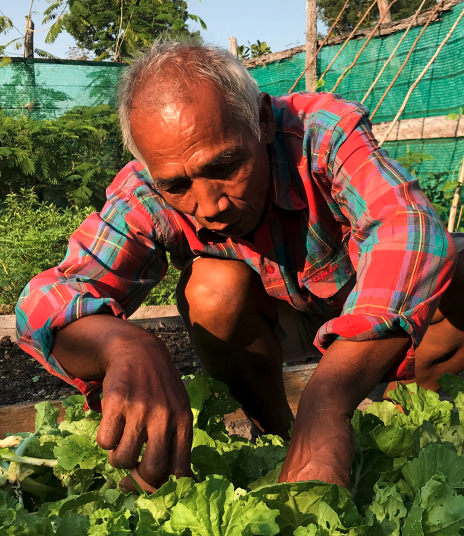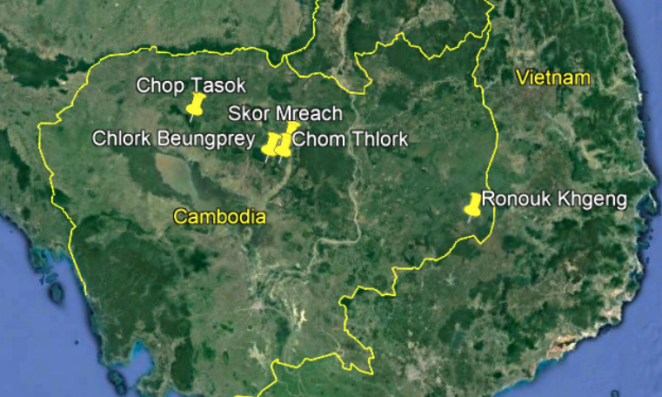Enhancing Climate Change Resilience of Rural Communities in Cambodia

Introduction
Cambodia is a country of 16 million people in Southeast Asia. The most prominent geographical feature is the Mekong River that extends across the country from north-tosouth. Approximately 80% of people live along the river in the low-lying central plains, where agriculture is highly dependent on rainfall.
The project is building climate adaptation near 5 community protected forests across the country. These areas are extremely vulnerable to climate change due to increasingly erratic rainfall, where dry seasons are getting drier and wet seasons are wetter, causing devastating floods and droughts.
The main approaches of the project are to reforest natural land to regulate soil waterflow; create patrols to halt illegal logging; establish ‘home-gardens’ with irrigation to diversify sources of food and income; and develop early warning climate systems to inform farmers’ planting decisions.

For more information on this case study, please download the pdf from the right-hand column.
Links to SDGs
SDG1: The project has trained 500 households (~5 people per house) in sustainable income-generating strategies such as chicken-raising, cricket-raising, ecotourism, and selling vegetables.
SDG2: Rice harvests were improved with drought-tolerant seeds (benefitting 872 families). The project set up households and schools with training to create home-gardens of vegetables (benefitting 1,193 families).
SDG6: 80% of the 1,900 households in the project sites report an improvement in access to water. Rainwater harvesting tankers and pumping wells were built to improve water security.
SDG13: Climate forecasts were used to inform and adjust planting schedules. The project is aiming for a 20% decrease in the climate change vulnerability index at all project sites, covering a total population of 9,271 people.
SDG15: A total of 1,875 hectares of degraded forests have been restored. The project donated saplings and supported patrol groups during the planting of more than a quarter of a million trees.
Climate Impacts
- Climate change is producing erratic rainfall in Cambodia, the effects of which are increased erosion on people’s farms, crop failures from droughts, and damaged infrastructure that hobbles rural markets.
- Only 19.5% of cultivated land in Cambodia benefits from irrigation, so the agricultural sector is dependent on rainfall.
- To counter the falls in agricultural yields, communities rely on illegal logging in protected forests to supplement food and income, whether it be collecting fuelwood or charcoal. These decimated forests once provided both climate and soil water regulation in the agriculturally vital Mekong River Basin.
- As the tree-cover has shrunk, people living on the mountains watched the once-abundant rain clouds disappear. With more than 80% of the population relying on agriculture for their livelihood, the risks are high.
“The big trees that used to be here attracted the rain. When they went, we found we had no water and our area was drying up.” – Yuth Thy, 46, local farmer.
Technologies & Methods
- Ecosystem-based adaptation (EbA) was central to the project’s activities. EbA is the tactic of using nature and healthy ecosystems to reduce the impacts of climate change.
- The forest restoration was carried out using multi-use native tree species that provide food, erosion control, timber, medicine, and fruit. The project also planted trees alongside 2,200 hectares of rice paddies to reduce erosion and enhance soil productivity.
- The project supported patrol groups during the planting of more than a quarter of a million trees. Local communities have expressed relief that rains are now returning.
- Rice harvests have greatly improved at project sites by using climate forecasting to inform planting schedules, thus reducing the impacts of drought and heat-stress.
- Rice yields were increased by distributing drought-tolerant rice varieties that are especially adapted to the local ecosystems. Households in the five community protected areas were also given access to improved rice storage techniques.
- Training has been given to households and schools to create ‘home-gardens’ of vegetables, which diversifies families’ agricultural produce. Previously, when rice harvests failed due to drought, people had to sell their animals or possessions to buy food.
- The project boosted the availability of water by supplying pumping wells and rain harvesting tankers. • Sustainable alternative livelihood strategies have been adopted by over 500 households so far, including chicken-raising, cricket-raising, and ecotourism.
- Over 450,000 fruit trees were distributed to all 1,900 families in the 5 target areas.
Video: Climate Action in Cambodia
[video:https://youtu.be/SnotF8PPUVU]From vegetable farming to cricket rearing, Cambodian communities are embracing strategies to adapt to climate change.
Related resources
- UN environment climate adaptation webpage
- Oasis dreaming: regreening the Djiboutian Desert
- The Gambia: Large Scale Ecosystem-based Adaptation
- Tanzania: Ecosystem-based Adaptation
- Rwanda: Reducing Vulnerability by Establishing Early Warning and Disaster Preparedness Systems
- The Gambia: Strengthening of Climate Change Early Warning System
(0) Comments
There is no content